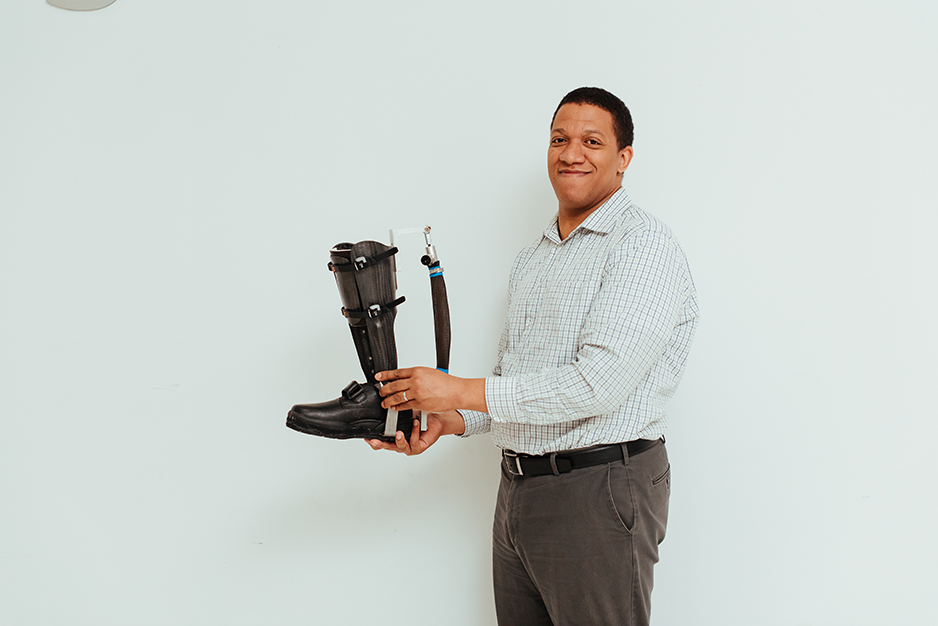According to Dr. Daniel Jacobs, a Mechanical Engineering professor at Temple’s College of Engineering, robots are very easy to understand.
“You can take their parts apart, you can put in new parts, they're very easy to simulate,” he explained. “Humans are not. We can only measure certain things from the surface.”
Dr. Jacobs explores physical human-robot interaction, a research niche in the broad interdisciplinary field of rehabilitation robotics that overlaps engineering and public health. He’s always asking, "How can robots be used to improve human health?”
Now, his research will be funded by a distinguished grant as Dr. Jacobs is a recipient of the National Science Foundation’s CAREER Award for his project “Integrating Sensorimotor Models into Human-Robot Collaboration in Gait, Posture, and Unsteady Tasks.” The prestigious award is selected by the Faculty Early Career Development Program and awarded to early-career faculty who show promise to become future research and education leaders.
Dr. Jacobs is the College of Engineering's eighth CAREER Award recipient since 2019, and he felt “great excitement” and “overwhelming joy” to be selected.
“Really knowing that I had achieved that big part of creating a new research area inside the field, and that being recognized by my peers, it was incredibly, incredibly exciting to be a part of that,” Dr. Jacobs said.
His research will focus on two grand challenges: creating a robot that acts like a person despite engineers having a limited understanding of how humans work compared to robots, and building a predictive model of how humans interact with wearable robotic devices.
Wearable robotic devices, such as exoskeletons, can assist those who have impaired mobility or other disabilities, but current robots do not yet have the intelligence to modify their behavior based on the user’s specific needs. Achieving these research goals could improve health and function for nearly 15 percent of Americans with mobility disabilities, which reduce their quality of life and increase the chance of injury.
Currently, devices are typically only optimized for one task, but human mobility is much more complex.
“We walk up and down small slopes, we go up and down steps, we go sit to stand. We have to walk through hallways, like in our engineering building in the CST, and dodge people on their phones who aren't even looking at you,” Dr. Jacobs said.
The research grant supports the argument that robots in this field need to and can do more than “just push and pull.”
“When these types of robots are wrong, they're exercise machines,” Dr. Jacobs said with a laugh. “They’re pushing against you, they're not working with you.”
So, Dr. Jacobs is trying to understand what it takes to make a wearable robotic device interface seamlessly with humans and how humans interact with robots. A robot created for humans to wear and assist mobility needs to work with them to have sensory reactions and change with the person, which Dr. Jacobs wants to incorporate in the physical design of his device.
“We are far, far away from Iron Man, but we will get there,” Dr. Jacobs said.
The research will lead to substantial advancements in human health by improving the quality of life for individuals who use wearable robotic devices, but the CAREER Award also aims to support broader educational impacts. These include participation and research partnerships with local pre-college and undergraduate programs to retain women and underrepresented minorities in interdisciplinary careers in engineering and medicine.
This unique field of engineering will familiarize young researchers with human research, “so there's a lot of ways to get people to think about engineering and human health and human consent,” Dr. Jacobs said about the broader impact of his work.
In the future, Dr. Jacobs hopes the model he develops with his research team in his Robotics in Interdisciplinary Science and Engineering (RISE) Lab — pun intended — will be able to be used with a host of different clinical populations.
“We hope to understand the interface between the human and robot in such a way that anybody who is interested in this physical human-robot interaction will be able to take what we've done and apply it to their systems,” he said.

